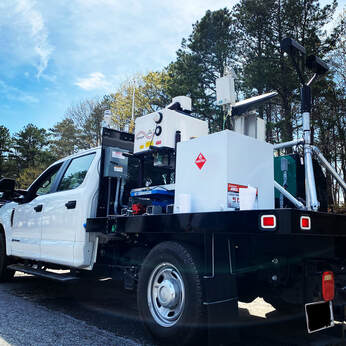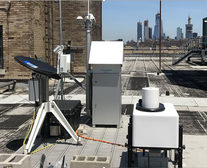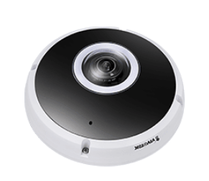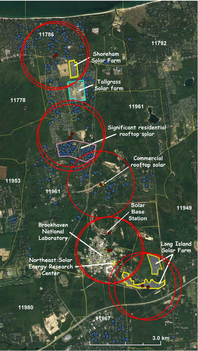Characterizing urban flow patterns
on the urban canyon, neighborhood and regional scales
Managing infrastructure and energy sources and sinks in urban centers is one of the most important development challenges of the 21st century. A key component of this challenge is acquiring currently unavailable multi-parametric, multi-scale data. Beyond allowing us to improve our fundamental understanding of weather phenomena, these new data can help evaluate and improve numerical models that aim to predict local weather in and around urban centers. Wind flow in the boundary layer impacts the redistribution of heat (related to heat wave and urban heat island effects) as well as of aerosol and gases (related to human health and safety); It is thus of great important to both weather and national security endeavors to improve our understanding of wind flow in cities.
To address these challenges, Brookhaven National Laboratory established the Center for Multiscale Applied Sensing (CMAS) whose mission is to conductsfundamental research to improve the understanding of meteorological factors directly relevant to an array of urban challenges. Our team specializes in acquiring, analyzing, and interpreting measurements in highly heterogeneous areas.
Unlike any other, our team has developed an array of programs that can remotely control weather sensors thus enabling the collection of high-resolution targeted observations.
Our interest is to establish a weather sensor network in the New York City to improve the monitoring of its local weather patterns.
The new generation of low-cost, small size and low-energy demand weather sensors is ideal for networking and remote installation on the rooftop of sky scrappers and on mobile truck platforms.
To address these challenges, Brookhaven National Laboratory established the Center for Multiscale Applied Sensing (CMAS) whose mission is to conductsfundamental research to improve the understanding of meteorological factors directly relevant to an array of urban challenges. Our team specializes in acquiring, analyzing, and interpreting measurements in highly heterogeneous areas.
Unlike any other, our team has developed an array of programs that can remotely control weather sensors thus enabling the collection of high-resolution targeted observations.
Our interest is to establish a weather sensor network in the New York City to improve the monitoring of its local weather patterns.
The new generation of low-cost, small size and low-energy demand weather sensors is ideal for networking and remote installation on the rooftop of sky scrappers and on mobile truck platforms.
Using low-cost sensors to NowCast solar energy availability
for solar energy generation
|
References:
Lamer K., and J. Heiser (02/2021) Advanced Solar and Load Forecasting Incorporating HD Sky Imaging: Phase III Q4 report. Submitted to DOE SETO Kalb P., K. Lamer and J. Heiser (11/2020) BNL Support for Advanced Solar & Load Forecasting Operations, Incorporating HD Sky Imaging Phase III report. Submitted to EPRI. Lamer K., P. Kalb, and J. Heiser (10/2020) Advanced Solar and Load Forecasting Incorporating HD Sky Imaging: Phase III Q3 report. Submitted to DOE SETO Kalb P., and coauthors (06/2020) Advanced Solar and Load Forecasting Incorporating HD Sky Imaging: Phase III Q2 report. Submitted to DOE SETO. |
Due to rapidly changing sky conditions, the available solar irradiance for energy production is subject to increasing and decreasing ramps and wide swings in amplitude. As the market penetration of solar energy continues to increase almost exponentially, these variations in solar production are beginning to have an impact on grid stability and increased wear on power switches. Solar power forecasting plays a critical role in operations for Independent System Operators (ISOs) and utilities. Accurate forecasts help maintain grid reliability, optimize production of renewables, and reduce operating costs. Of particular interest to the ISOs and utilities are sudden changes in solar irradiance, termed “ramp events,” due to the movement of clouds. One significant impact of ramp events on the grid is additional ancillary service requirements necessary to manage such variability. Ramp events can also cause voltage fluctuations in the distribution grids and trigger actions of automated line equipment (e.g., tap changers), leading to additional maintenance costs. In high penetration solar regions, forecasts must be made for both transmission and distribution connected resources – either behind the meter or on the distribution system. Particularly for distributed solar resources, forecasting can be a challenge due to the lack of visibility of the resource.
Brookhaven National Laboratory has been working towards nowcasting global horizontal irradiance using low-cost technologies for several years now. The Solar NowCasting technology being developed by Brookhaven National Laboratory is a 0 – 30 min solar “nowcasting” technology applicable to a scale covering both large generating facilities and residential, distributed solar installations that relies on a network of ground-based HD security cameras and surface pyranometers. Global horizontal irradiance forecasts are being produced for both regions using 8 ground-based HD cameras and at least 2 surface pyranometers to enable the training of a machine learning algorithm. When stitched together, the camera images can be used to forecast the impact of clouds on available solar irradiance over a domain of ~50 km2.
Phase I of the project was the engineering scale up conceptual design stage. Phase II, completed in December 2018, was the initial field test and demonstration, in which the technology was scaled up by a factor of 20 times and successfully demonstrated in a of eastern Long Island. In Phase III, our team is currently working on demonstrating this technology in an additional forecasting network in upstate NY and over a longer time period of at least a full year in order to gather sufficient data to evaluate performance against the persistence and smart persistence models using the Solar Arbiter.
Brookhaven National Laboratory has been working towards nowcasting global horizontal irradiance using low-cost technologies for several years now. The Solar NowCasting technology being developed by Brookhaven National Laboratory is a 0 – 30 min solar “nowcasting” technology applicable to a scale covering both large generating facilities and residential, distributed solar installations that relies on a network of ground-based HD security cameras and surface pyranometers. Global horizontal irradiance forecasts are being produced for both regions using 8 ground-based HD cameras and at least 2 surface pyranometers to enable the training of a machine learning algorithm. When stitched together, the camera images can be used to forecast the impact of clouds on available solar irradiance over a domain of ~50 km2.
Phase I of the project was the engineering scale up conceptual design stage. Phase II, completed in December 2018, was the initial field test and demonstration, in which the technology was scaled up by a factor of 20 times and successfully demonstrated in a of eastern Long Island. In Phase III, our team is currently working on demonstrating this technology in an additional forecasting network in upstate NY and over a longer time period of at least a full year in order to gather sufficient data to evaluate performance against the persistence and smart persistence models using the Solar Arbiter.




